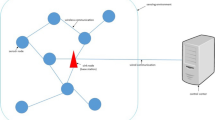Abstract
Based on the sensing network to implement the fire emergency escape path planning. Unlike other planning methods, this paper uses grid technology to consider factors such as the impact of crowd density on travel time, smoke diffusion, and the upper limit of space/aisle accommodation. At the time of the fire, the evacuation path planning problem at each location is transformed into the optimization. In the model, a balanced evacuation was considered to achieve the goal of evacuation of the crowd. In the paper, the simulated annealing algorithm was used to solve the optimization model and the experimental results were verified.
Access this chapter
Tax calculation will be finalised at checkout
Purchases are for personal use only
Similar content being viewed by others
References
Radianti, J., Granmo, O.-C., Bouhmala, N., Sarshar, P., Yazidi, A., Gonzalez, J.: Crowd models for emergency evacuation: a review targeting human-centered sensing. In: Proceedings of the 46th Annual Hawaii International Conference on System Sciences (HICSS 2013), pp. 156–165. IEEE, Wailea, Hawaii, January 2013
Tabirca, T., Brown, K.N., Sreenan, C.J.: A dynamic model for fire emergency evacuation based on wireless sensor networks. In: Proceedings of International Symposium on Parallel Distributed Computing, pp. 29–36, June 2009
Hadzic, T., Brown, K.N., Sreenan, C.J.: Real-time pedestrian evacuation planning during emergency. In: Proceedings of IEEE International Conference on Tools Artificial Intelligence, pp. 597–604 (2011)
Escolar, S., Villa, D., Villanueva, F., Cantarero, R., Lopez, J.: An adaptive emergency protocol for people evacuation in high-rise buildings. In: IEEE Symposium on Computers And Communication (ISCC). https://doi.org/10.1109/iscc.2016.754376
Author information
Authors and Affiliations
Corresponding author
Editor information
Editors and Affiliations
Rights and permissions
Copyright information
© 2019 Springer Nature Singapore Pte Ltd.
About this paper
Cite this paper
Chang, CL., Tsai, YL. (2019). The Modeling of Path Planning for Fire Evacuation. In: Chang, CY., Lin, CC., Lin, HH. (eds) New Trends in Computer Technologies and Applications. ICS 2018. Communications in Computer and Information Science, vol 1013. Springer, Singapore. https://doi.org/10.1007/978-981-13-9190-3_41
Download citation
DOI: https://doi.org/10.1007/978-981-13-9190-3_41
Published:
Publisher Name: Springer, Singapore
Print ISBN: 978-981-13-9189-7
Online ISBN: 978-981-13-9190-3
eBook Packages: Computer ScienceComputer Science (R0)




